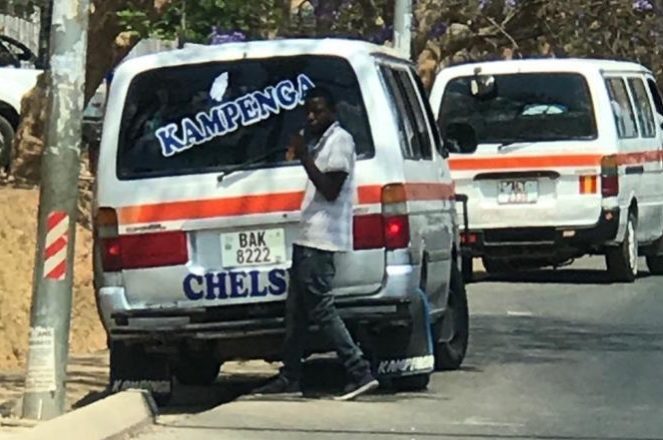27 September 2022 In Blog Post, Informal Transport, News
Enhancing the Utility and Sustainability of Popular Transport

Minibuses are the main form of transport in Lusaka, the capital city of Zambia. These minibuses are mostly utility vans transformed to carry passengers. Minibuses criss-cross the city from the early hours until late in the evening. Their service is flexible, they are not scheduled, and the conductor and driver can change routes whenever they feel like it. These buses stop for anyone anywhere, and thus they are considered to contribute to traffic chaos in Lukasa.
Buses in Lusaka are all under private ownership, ranging from individuals who own one or two buses to individuals who own hundreds of them. There were approximately 2,600 registered minibuses in the capital in 2013, with an estimated 500 buses added since then (however, many others have been decommissioned due to accidents and poor maintenance). The transport sector in Zambia was largely privatised after 1991; therefore, neither the local authority nor the central government owns any buses. This means that some form of regulation will be necessary to reduce emissions in the sector and to involve the minibus services in efforts to achieve global climate goals.
In Zambia, as in most developing countries, informal or popular transport is not considered an issue that requires urgent attention in relation to its impact on climate change (in contrast to the destruction of forests and wetlands). However, since the future of Africa’s growth projects rapid expansion of towns and cities, the time to start talking about carbon emissions is now. Whilst there are no studies that show the exact level of emissions generated by informal transport, it is clear that there is a considerable contribution due to the large number and general age of the vehicles.
The contribution of popular transport to carbon emissions and air pollution must be addressed, and therefore, increased governance and regulation of the public transport sector must become a priority in Lusaka. One way to start is by reducing the number of vehicles on the road (e.g. by replacing 12-seater buses with 24-seater versions). The 12-seater buses must make several trips to break even daily, which thus increases kilometres travelled, consumption of fossil fuels and emissions. The use of bigger buses should become mandatory for up to at least 70 percent of the trips in a city like Lusaka. The smaller buses could be used to supply passengers from outlying residential areas to the bigger buses. This would require secondary bus stations and rezoning.
A second type of intervention that could contribute to reducing emissions is improved planning and operations. In Lusaka, minibuses tend to stop and wait at the same point until they have a full load, which increases traffic congestion during peak hours. Emissions could be reduced if the bus owners work as co-operatives sharing profits equally at the end of the day. This would allow them to work on a time-schedule basis rather than a full capacity basis. For instance, buses could stay at individual bus stop for 2 minutes and designated bus stations for 10 minutes, which would allow a continuous flow of buses throughout the network.
Other innovative measures such as placing solar panels on top of the buses as they run through the city could be a way of capturing energy to charge electric batteries and other on-board equipment (similar to the FlixBus in the Netherlands). Making improvements to existing buses might be simpler than manufacturing new electric buses (based on experience in Uganda in which a promising project for electric buses was abandoned because of a lack of funding).
Beyond thinking about reducing greenhouse gas reductions in the transport sector, it is essential that we think about the users of these services when reimagining the race to zero in the Global South. Most of the passengers who rely on informal transport live in areas that are not easy to access and have limited mobility options. Informal transport services are not predictable, and the poor and marginalised are the ones who pay for the consequences of these issues. Poor organisation of these services cause frequent service delays for users, and when the cost of fuel goes up, customers are expected to pay increased rates more almost immediately. In situations with limited mobility alternatives, users may need to limit their trips or walking part of the way to and from their destinations even during periods of extreme heat or heavy rain. Any changes in policy or regulation to the informal transport sector should thus be made with this cohort of city residents in mind.
On the other hand, with high unemployment in Zambia, a just transition towards sustainable and decarbonised transport must also consider existing operators. In September 2017, the then Minister of Transport announced that the government planned to ban minibuses starting in 2019. Owners and operators expressed concern over the increased poverty that would be caused by the government’s proposed ban. As of September 2022, there has not been any mention of this action by the new United Party for National Development government that came into power in August 2021. The topic of phasing out minibuses is politically charged and emotive in the context of high poverty and unemployment levels. If the phasing out of minibuses were to happen, there would be a need to retrain and re-assign some of these ‘informal’ workers and empower them in other ways.
The focus of any regulatory efforts for informal transport in the future should be to improve the level of service provided by the public transport sector and to improve its efficiency to reduce negative impacts on society and the environment. This would require extensive research to assess the costs and benefits of available options. The financing of research and design in urban transport should increase going forward, and options such as solar-powered or electric-powered vehicles should be considered in long-term transport planning. In the meantime, messaging on the dangers of increased transport emissions should increase to create awareness among bus owners and commuters alike.

Wilma Nchito
Wilma Nchito is the Director of Research and Postgraduate Studies at the University of Zambia. She is an urban geographer with an interest in urban mobility and equity. Other interests include urban informality, cities and climate change, urban service provision, small town development, and walking as a means of transport.
Wilma works closely with the Lusaka (Zambia) City Council on projects including the development of Local Area Plans in which transport issues are highlighted. Her most recent project has been on Inclusivity in major road infrastructure projects which was funded by the Volvo Research and Educational Foundations (VREF).

Wilma Nchito
Wilma Nchito is the Director of Research and Postgraduate Studies at the University of Zambia. She is an urban geographer with an interest in urban mobility and equity. Other interests include urban informality, cities and climate change, urban service provision, small town development, and walking as a means of transport.
Wilma works closely with the Lusaka (Zambia) City Council on projects including the development of Local Area Plans in which transport issues are highlighted. Her most recent project has been on Inclusivity in major road infrastructure projects which was funded by the Volvo Research and Educational Foundations (VREF).